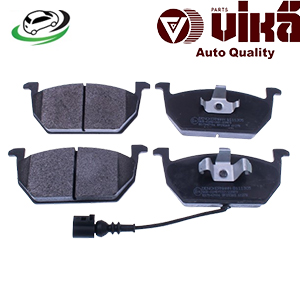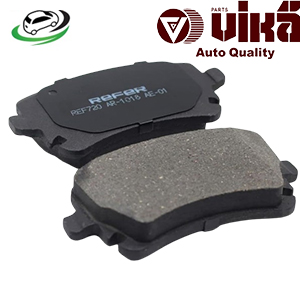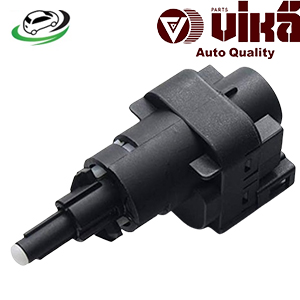-13%
Get AUDI A3 8P 2.0T/TDI/3.2L/V6 3.2L / VW Golf V 2.0T/2.5/TDI Brake Light Switch 6Q0945511
The brake light switch is a crucial component of a vehicle’s electrical system, responsible for activating the brake lights whenever the driver applies the brakes. This simple yet essential switch plays a significant role in vehicle safety by alerting other drivers of a vehicle’s intention to slow down or stop. Understanding its function, types, installation procedures, and maintenance practices can help ensure that your vehicle operates safely and efficiently.
Function of the Brake Light Switch
- Activation of Brake Lights: The primary function of the brake light switch is to turn on the brake lights when the brake pedal is pressed. This activation not only alerts drivers behind the vehicle that the brakes are engaged, but it also serves as a safety measure to prevent rear-end collisions.
- Cruise Control System: In vehicles equipped with a cruise control system, the brake light switch also plays a vital role. When the brake pedal is pressed, the brake light switch signals the cruise control module to disengage the system. This ensures that the vehicle slows down safely when the driver wants to take control.
- Transmission Safety: The brake light switch may also be connected to the transmission system. In automatic vehicles, it prevents the driver from shifting out of “Park” without pressing the brake pedal, enhancing safety.
- Electronic Stability Control: In modern vehicles, the brake light switch can be integrated with the vehicle’s electronic stability control (ESC) system. This integration helps the ESC system monitor and react to braking actions, ensuring better vehicle stability in various driving conditions.
Types of Brake Light Switches
Brake light switches come in various designs and technologies, and understanding these types can help you choose the right replacement if needed.
- Mechanical Brake Light Switch: Mechanical brake light switches are activated by a physical action. When the brake pedal is pressed, a lever or plunger inside the switch is pushed, completing the electrical circuit and turning on the brake lights. These switches are often found in older vehicles and are relatively simple in design.
- Advantages:
- Simple design and easy to replace
- Reliable operation
- Disadvantages:
- Prone to wear over time
- Less sensitive to minor pedal movements
- Advantages:
- Electronic Brake Light Switch: Electronic brake light switches use a sensor to detect the position of the brake pedal. When the pedal is pressed, the sensor sends a signal to the vehicle’s computer, which then activates the brake lights. These switches are commonly used in modern vehicles due to their enhanced accuracy and reliability.
- Advantages:
- More precise activation
- Longer lifespan
- Disadvantages:
- More complex and expensive
- Dependent on electronic components
- Advantages:
- Hydraulic Brake Light Switch: Hydraulic brake light switches are integrated into the brake hydraulic system. They are activated by changes in hydraulic pressure when the brake pedal is pressed. This type of switch is commonly found in vehicles with hydraulic brake systems.
- Advantages:
- Reliable activation based on actual braking force
- Often more durable
- Disadvantages:
- More complicated installation
- May require specific hydraulic system compatibility
- Advantages:
Choosing the Right Brake Light Switch
When selecting a replacement brake light switch, consider the following factors:
- Vehicle Compatibility: Ensure the switch is compatible with your vehicle’s make and model. Different vehicles may have specific switch designs and electrical connections.
- Type of Switch: Determine the type of brake light switch your vehicle uses (mechanical, electronic, or hydraulic). Consult the owner’s manual or a mechanic if unsure.
- Quality and Reliability: Choose high-quality components from reputable manufacturers. Quality switches often have better durability and performance.
- Cost: While it may be tempting to opt for the cheapest option, consider the long-term benefits of investing in a quality brake light switch that will last longer and perform reliably.
Installation of a Brake Light Switch
Replacing a brake light switch is a straightforward process that can be done with basic tools. Here’s a step-by-step guide for installation:
Tools and Materials Needed:
- Replacement brake light switch
- Screwdriver set
- Socket set
- Wire connectors (if necessary)
- Safety goggles
- Gloves
Installation Steps:
- Safety First: Ensure the vehicle is parked on a flat surface, engage the parking brake, and wear safety goggles and gloves.
- Locate the Brake Light Switch: The brake light switch is usually located above the brake pedal, mounted on the brake pedal assembly. You may need to remove a panel or cover to access it.
- Disconnect the Battery: For safety, disconnect the negative terminal of the vehicle’s battery to prevent electrical shorts during the installation.
- Remove the Old Switch: Disconnect the wiring harness from the old brake light switch. Depending on the design, you may need to unscrew or unclip the switch from its mounting point. Carefully remove the switch.
- Install the New Switch: Position the new brake light switch in the same location as the old switch. If applicable, secure it with screws or clips. Reconnect the wiring harness to the new switch.
- Adjust the Switch: Some switches may require adjustment to ensure proper activation. Adjust the switch according to the manufacturer’s specifications, typically done by pushing the brake pedal to check for correct engagement.
- Reconnect the Battery: Once the new switch is installed and adjusted, reconnect the negative terminal of the battery.
- Test the Brake Lights: With the vehicle in the ignition position (but the engine off), press the brake pedal and check if the brake lights illuminate. If they do, the installation was successful.
Maintenance of the Brake Light Switch
Regular maintenance of the brake light switch is essential for ensuring optimal performance and safety. Here are some maintenance tips to consider:
- Regular Inspections: Periodically check the brake lights for functionality. If you notice that the brake lights do not illuminate when the pedal is pressed, the switch may be faulty and require replacement.
- Check for Wear and Tear: Inspect the switch for any visible signs of damage, such as cracks or corrosion. If the switch appears worn, it’s advisable to replace it before it fails.
- Electrical Connections: Ensure that the electrical connections to the brake light switch are clean and secure. Loose or corroded connections can lead to intermittent brake light operation.
- Test Functionality: Conduct regular tests of the brake lights, especially after performing any maintenance on the braking system or electrical components.
- Consult a Professional: If you experience persistent issues with the brake lights, such as flickering or intermittent operation, consult a qualified mechanic for a thorough inspection.
Signs of a Faulty Brake Light Switch
Recognizing the signs of a faulty brake light switch can help you address the issue before it becomes a significant problem. Common symptoms include:
- Brake Lights Not Illuminating: The most obvious sign of a faulty switch is when the brake lights do not activate when the brake pedal is pressed.
- Brake Lights Stuck On: If the brake lights remain illuminated even when the brake pedal is not engaged, it may indicate that the switch is stuck in the “on” position.
- Cruise Control Malfunction: A malfunctioning brake light switch may cause issues with the cruise control system, preventing it from disengaging when the brake pedal is pressed.
- Transmission Shift Issues: In automatic vehicles, if you cannot shift out of “Park” without pressing the brake pedal, it may signal a faulty switch.
- Warning Lights: Some vehicles may display warning lights on the dashboard if there is an issue with the brake light switch.
Conclusion
The brake light switch is a vital component of a vehicle’s safety system, ensuring that brake lights function correctly when the driver applies the brakes. Understanding its function, types, installation, and maintenance practices can help vehicle owners ensure their cars operate safely and effectively. Regular inspections, prompt replacements, and attention to signs of malfunction can enhance overall vehicle safety and prevent accidents. By maintaining the brake light switch and ensuring its reliable operation, drivers can contribute to safer roads for themselves and others.
Follow us on Facebook for more parts.




Reviews
Clear filtersThere are no reviews yet.